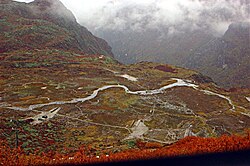Yadong County
Yadong County | |
|---|---|
| Tibetan transcription(s) | |
| Chinese transcription(s) | |
 | |
 Location of Yadong County within Tibet | |
| Country | China |
| Province | Tibet |
| Prefecture | Shigatse Prefecture |
| Capital | Lingma |
| Time zone | UTC+8 (China Standard) |
Chomo (Yadong) County (Tibetan: གྲོ་མོ་རྫོང༌།, Wylie: gro-mo rdzong; simplified Chinese: 亚东; traditional Chinese: 亞東; pinyin: Yàdōng; Wade–Giles: Ya-tung) is a frontier county and trade-market of Tibet, situated in the mouth of the Chumbi valley near the Indian frontier. It lies in the middle part of Himalayas and the south of Tibet Autonomous Region, covering about 4,306 square kilometers with a population of 10,000. In the Tibetan language, Yatung is said to mean "rushing deep valley".
The town of Yadong (Chomo) 27°29′22″N 88°54′21″E / 27.48944°N 88.90583°E is very close to the borders of both the Indian state of Sikkim and Bhutan and has a hotel, a guest house, some government offices and army barracks. [1]
The famous local specialities are Yadong fish, barley wine and others. Pali Town of Yadong is noted for being the highest town of the world. The main tourist sites of Yadong are Donggar Monastery, Garju Monastery and Kangbu Hotspring. Yadong is connected to the Indian state of Sikkim via the Nathula Pass.
According to the Convention of 1890–93, the market at Yadong was opened to India, and the conduct of the Tibetans in building a wall across the road between Yadong and Lhasa was reported to be one of the incidents that led up to the British invasion of Tibet in 1904. According to the treaty of that year, a British trade-agent was to be stationed at Yadong.
As part of the China Western Development strategy, the Chinese government planned to extend the Qinghai–Tibet Railway from Lhasa to Yadong near the Nathu La Pass that marks the China–India border. [2]
Settlements
References
- ^ Buckley,Michael and Strauss, Robert. Tibet: a travel survival kit, p. 163. (1986) Lonely Planet Publications, Victoria, Australia. ISBN 0-908086-88-1.
- ^ Extension plans. Retrieved June 28, 2006
- This article incorporates text from a publication now in the public domain: Chisholm, Hugh, ed. (1911). Encyclopædia Britannica (11th ed.). Cambridge University Press.
{{cite encyclopedia}}: Missing or empty|title=(help)

